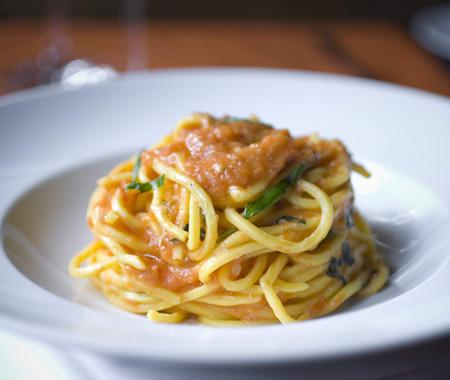Recipe
August 4, 2010
Spaghetti With Fresh Tomato Sauce & Basil Recipe

Step 1: Bring a large pot of water to a boil. Have a large bowl of ice water nearby. Cut a small X on the bottom of each tomato. Ease about five tomatoes in the pot and cook, let boil for about 15 seconds, and then promptly move them to the waiting ice water. (Do this with the remaining tomatoes.) Pull off the skin with the tip of a paring knife. If the skin sticks, try a vegetable peeler using a gentle sawing motion. Cut the tomatoes in half and use your finger to flick out the seeds.
Step 2: In a wide pan, heat the 1/3 cup of olive oil over medium-high heat until quite hot. Add the tomatoes, red pepper flakes, and season lightly with the salt and pepper. (I always start with a light hand with the salt and pepper because as the tomatoes reduce, the salt will become concentrated.) Let the tomatoes cook for a few minutes to soften. Then, using a potato masher, chop the tomatoes finely. Cook the tomatoes for 20-25 minutes, until the tomatoes are tender and the sauce has thickened. (You can make the sauce, which yields about 3 cups, ahead of time. Refrigerate it for up to 2 days or freeze it for longer storage.)
Step 3: Bring a large pot of amply salted water to a boil. Cook the spaghetti until just shy of al dente. Reserve a little of the pasta cooking water. Add the pasta to the sauce and cook over medium-high heat, gently tossing the pasta and the sauce together with a couple of wooden spoons and a lot of exaggerated movement (you can even shake the pan) until the pasta is just tender and the sauce, if any oil had separated from it, now looks cohesive. (If the sauce seems too thick, add a little pasta cooking liquid to adjust it.) Take the pan off of the heat and toss the butter, basil and cheese with the pasta in the same manner (the pasta should take on an orange hue) and serve immediately.
Directions
Yield:
Step 1: Bring a large pot of water to a boil. Have a large bowl of ice water nearby. Cut a small X on the bottom of each tomato. Ease about five tomatoes in the pot and cook, let boil for about 15 seconds, and then promptly move them to the waiting ice water. (Do this with the remaining tomatoes.) Pull off the skin with the tip of a paring knife. If the skin sticks, try a vegetable peeler using a gentle sawing motion. Cut the tomatoes in half and use your finger to flick out the seeds.
Step 2: In a wide pan, heat the 1/3 cup of olive oil over medium-high heat until quite hot. Add the tomatoes, red pepper flakes, and season lightly with the salt and pepper. (I always start with a light hand with the salt and pepper because as the tomatoes reduce, the salt will become concentrated.) Let the tomatoes cook for a few minutes to soften. Then, using a potato masher, chop the tomatoes finely. Cook the tomatoes for 20-25 minutes, until the tomatoes are tender and the sauce has thickened. (You can make the sauce, which yields about 3 cups, ahead of time. Refrigerate it for up to 2 days or freeze it for longer storage.)
Step 3: Bring a large pot of amply salted water to a boil. Cook the spaghetti until just shy of al dente. Reserve a little of the pasta cooking water. Add the pasta to the sauce and cook over medium-high heat, gently tossing the pasta and the sauce together with a couple of wooden spoons and a lot of exaggerated movement (you can even shake the pan) until the pasta is just tender and the sauce, if any oil had separated from it, now looks cohesive. (If the sauce seems too thick, add a little pasta cooking liquid to adjust it.) Take the pan off of the heat and toss the butter, basil and cheese with the pasta in the same manner (the pasta should take on an orange hue) and serve immediately.
Chris Villano

